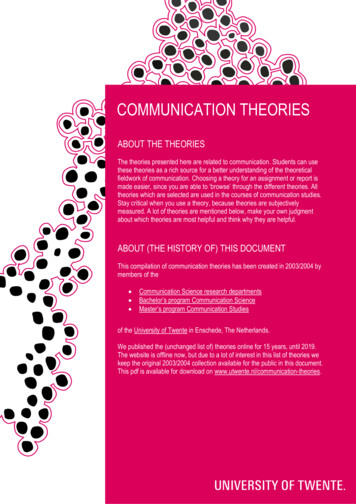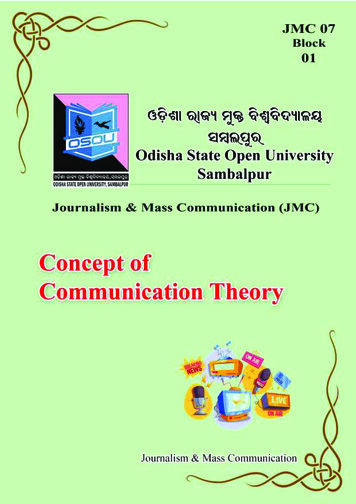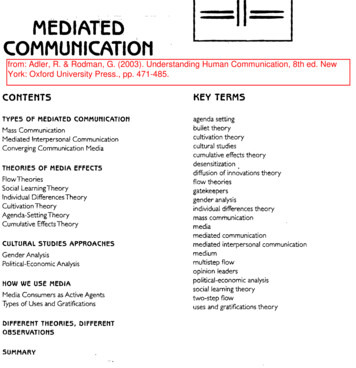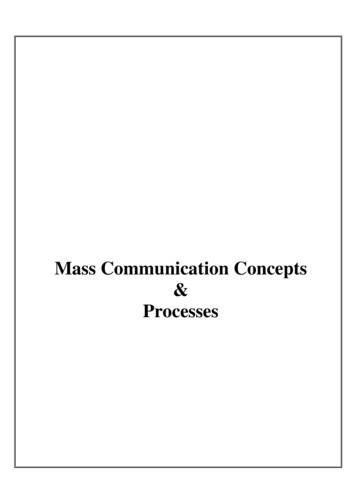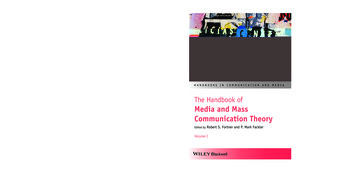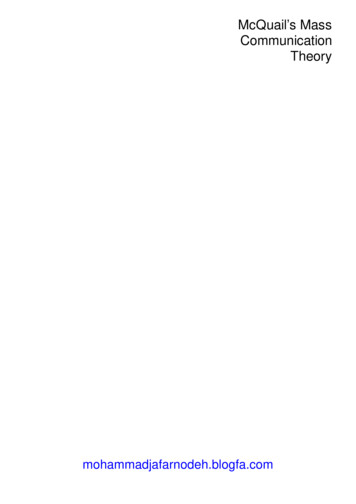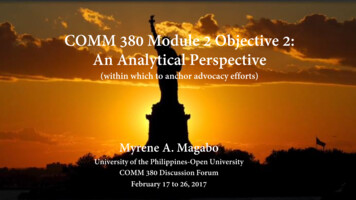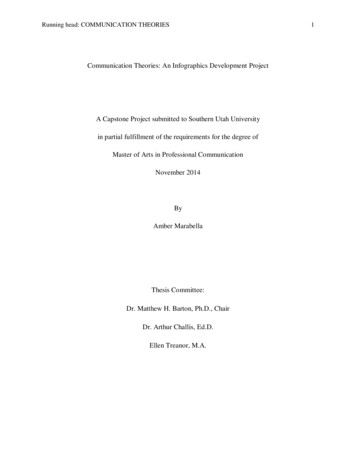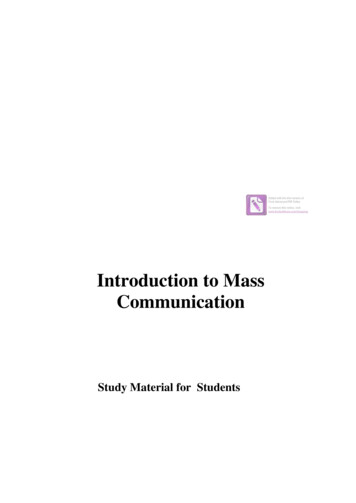
Transcription
FMASS COMMUNICATIONIFIFTH EDITIONMELVIN L. DEFLEUR and SANDRA BALL-ROKEACH
THEORIESOFM ASSCOMMUNICATION
THEORIESOFM ASSCOMMUNICATIONFIFTH EDITIONMelvin L. DeFleurJohn Ben Snow ProfessorS. I. Newhouse School of CommunicationsSyracuse UniversitySandra J. Ball-RokeachProfessorThe Annenberg School of CommunicationUniversity of Southern California 1.4Nell.NallLongmanNew York & London
Theories of Mass Communication, 5th editionCopyright 1989 by Longman Inc. All rights reserved.No part of this publication may be reproduced, storedin aretrieval system, or transmitted in any formor by any means, electronic, mechanical, photocopying,recording, or otherwise, without the prior permissionof the publisher.Longman Inc., 95 Church Street, White Plains, N.Y. 10601Associated companies:Longman Group Ltd., LondonLongman Cheshire Pty., MelbourneLongman Paul Pty., AucklandCopp Clark Pitman, TorontoPitman Publishing Inc., New YorkExecutive editor: Gordon T. R. AndersonProduction editor: Camilla T. K. PalmerText design: Jill Francis WoodCover design: Paul AguleText art: Hal KeithProduction supervisor: Kathleen RyanLibrary of Congress Cataloging-in-Publication DataDeFleur, Melvin L. (Melvin Lawrence), 1923—Theories of mass communication /Melvin L. DeFleur, Sandra J. BallRokeach.p. cm.Includes index.ISBN 0-582-99870-01. Mass media—Social aspects—History. 2. Mass media—Socialaspects—United States—History. I. Ball-Rokeach, Sandra.II. Title.HM258.D35 1988302.2 34--dc19ISBN 0-582-99870-0ISBN (1-8013-0007-X93 92 91 90 89 88(ID)(csd)9 8 76 54 32 188-9245CIP
Table of ContentsPrefacexiPART I: THE ORIGINS OF MASS COMMUNICATION1Chapter 1 Stages in the Development of HumanCommunication3The Beginnings4A Theory of TransitionsThe Age of Signs and SignalsThe Age of Speech and LanguageThe Age of WritingThe Age of PrintThe Age of Mass Communication71115172125Assessing the Nature and Influence of MassCommunicationThe Central QuestionsSocial Paradigms: The Organization of SocietyPsychological Paradigms: The Human Individual27282938Notes43Chapter 2 The Emergence of the Mass Press46Recurrent Patterns in Media Development48V
viCONTENTSThe Mass PressForerunners of the NewspaperNewspapers in the American ColoniesNewspapers for Everyone49505152The Period of Rapid DiffusionThe Evolution of Social and Mechanical TechnologyThe Peak of Newspaper Popularity545555Conflict and the Changing NewspaperYellow JournalismEmerging Systems of Social Control565657The Future of the Mass Press58Notes61Chapter 3 The Development of Motion Pictures62The Evolution of TechnologyProjection and the Camera ObscuraThe Illusion of Continuous MotionCapturing the Image of the Camera ObscuraMotion Pictures Become aReality64Social Evolution: The Movies as aMass MediumThe Content and Audiences of the First FilmsThe Nickelodeon EraThe Movies Mature75Quantitative Patterns80Notes83Chapter 4 The Establishment of the Broadcast Media6467697475767885The Evolution of TelecommunicationExpanding Communication NeedsScientific Progress in Understanding ElectricityThe TelegraphThe Wireless Telegraph8586889193From Wireless Telegraph to RadiotelephoneTransmitting the Human VoicePrivate Ownership and the Profit Motive949596The Radio Music BoxThe Issue of ControlScheduled Broadcasting BeginsThe Problems of Interference and FinanceRadio Goes CommercialThe Golden Age of Radio979899101105106
CONTENTSviiDevelopment of the Television IndustryThe TV Set as Status SymbolImpediments to GrowthThe Rapid Adoption of TelevisionThe Arrival of Cable TVThe Video Cassette Recorder116An Overview120Notes121Chapter 5 The Mass Media as Social Systems110111111112113123The Stability of Media in American Society126The Long History of the Problem127The Basics of Functional Analysis129Structure and Function in Media SystemsLow-Taste Content as aRepetitive PhenomenonThe Components and Boundaries of the SystemThe External Conditions131Maintaining System Stability137Notes141132133136PART II: THE EFFECTS OF MASS COMMUNICATION143Chapter 6 Mass Society and the Magic Bullet Theory145The Evolutionary Paradigm and the Concept of MassSocietyComte's Conception of the Collective OrganismSpencer's Organic AnalogyTiinnies' Theory of Social BondsDurkheim's Analysis of the Division of Labor148148151152155The Emergence of the Theory of Mass Society159Mass Society and the Magic Bullet Theory160Wartime Propaganda and Beliefs of Media PowerMagic Bullet Theory as aCorollary of UnderlyingPostulatesNotesChapter 7 Theories of Selective InfluenceThe Individual Differences TheoryLearning versus Inheritance as aSource of IndividualDifferencesPsychographics and Market Segmentation160164166168172172179
viiiCONTENTSThe Social Differentiation TheoryThe Significance of Social ChangeSocial Differentiation in Modern SocietyThe Rise of Empirical Research in SociologySubculturesThe Uses and Gratifications Perspective"Demographics" as aBasis of Market SegmentationThe Link between Basic and Applied ResearchSelective Influences in the Mass CommunicationProcess181182184184185187188188The Social Relationships TheoryThe Two-Step Flow of Communication and InfluenceThe Adoption of Innovation190192193The Contemporary Significance of the Selective InfluenceTheories195Notes199Chapter 8 Socialization and Theories of Indirect Influence189202Short-Term Versus Long-Term PerspectiveThe Constraints of ParadigmThe Constraints of Method203203204The Media as Agents of SocializationThe Nature of SocializationSocialization and the IndividualSocialization and Society207208209211Modeling TheorySocial or Observational Learning TheoryThe Modeling Process212212216Social Expectations TheorySocial Organization TheoryMedia Portrayals as Sources of Social Expectations219219223Notes227Chapter 9 Mass Communication and the Construction ofMeaning228The Search for Principles in an Age of Transition230The Ancient Question: How Do We Know Reality?Concepts: The Foundations of KnowledgeConventions: The Basis of CommunicationConduct: The Consequences of Knowing RealityThe Lengthy Search for the Principles of Knowledge234236237240242
CONTENTSContemporary Answers: Social Construction TheoriesLinguistics: Knowing Reality Through LanguageAnthropology: Cultural Relativity in ConstructingMeaningsSociology: Symbolic Interaction and Conceptions ofRealitySocial Psychology: Schemata as Meanings for RealityMass Communications and the Influence of MediatedRealityThe Meaning Construction Function of the PressCultivation TheoryThe Agenda-Setting Function of the PressThe Speech and Language Functions of the MediaNotesChapter 10ix248248250252255258259262264265269Theoretical Strategies for Persuasion272The Psychodynamic StrategyCognitive Factors and BehaviorModifying Cognitive Factors to Influence Behavior275276278The Sociocultural StrategySocial Expectations and BehaviorModifying Social Expectations to Influence Behavior281281The Meaning Construction StrategyConstructions of Meanings and BehaviorModifying Meanings to Influence Behavior289289290Notes293283PART III: THE MEDIA IN CONTEMPORARY SOCIETY295Chapter 11297Media System Dependency TheoryThe Roots of Media Effects Theories299Conceptualizing Media Dependency RelationshipsThe Two-Way Nature of Media DependencyRelationshipsDependencies between Individuals and Media Systems302Basic Paradigms andContributions ofContributions ofContributions ofParadigmsMedia System Dependency Theorythe Cognitive Paradigmthe Symbolic Interactionist Paradigmthe Conflict and Structural Functional304305310310315318
xCONTENTSAccounting for Change in Media Dependency RelationsContributions of the Evolutionary ParadigmThe Ripple Effect of Change321321322Media and Society324Notes326Chapter 12Emerging Media Systems328The Influence of ComputersPersonal ComputersComputers in the Service Economy329329331Computers and the Mass Media335Basic Cable TelevisionSatellite-Delivered Cable TVDirect Broadcast Satellite SystemsInteractive Communication SystemsTelephone-Based SystemsTelevision-Based Interactive MediaVideotexTransforming Interactive Technologies to 53
PrefaceThe present fifth edition of Theories of Mass Communication is amuchrevised version. Although the chapters dealing with the historical development of the several media have been retained relatively unchanged from earlier editions, the remaining chapters have been eithersignificantly modified or are completely new to this edition.Several completely new theoretical perspectives are offered asframeworks for interpreting the influence of communications on individuals, society, and culture. For example, the first chapter contains atheory of transitions in human communication. It is intended to narrowthe gap between the study of human communication as a generalprocess and the specific study of mass communication. It focuses verybroadly on what happens to people and society when completely newforms of communication are introduced. Other new perspectives areincluded in chapters that follow.In Chapters 2, 3, and 4numerical data on the adoption, spread, anduse of the various traditional media have been brought up to date.Additional information has been added to describe the origins anddevelopment of newer media, such as cable television and the videocassette recorder, now important components of our media systems.Chapter 5 continues to focus on the mass media as social systems.It ties their structure and functions to the theoretical perspectivesoffered in Chapter 1 and shows that mass communication and theseveral media currently operating in the United States constitute adeeply institutionalized system that is tightly integrated with the Amerxi
xiiPREFACEican society as a whole. In particular, the analysis shows why it isunlikely that the media will discontinue their production of popularculture and their emphasis on content of arelatively unsophisticatedlevel in the near future.Chapter 6 has been somewhat revised from earlier editions. Itprovides an important background for understanding the type of society in which the media emerged and why the earliest interpretationsof their influences and effects took the particular direction that theydid. The idea of a "mass" society continues to play a part in muchthinking about the media, but the earliest theoretical perspectives derived from such considerations have become less relevant to modernanalyses. Nevertheless, this chapter provides an important startingpoint in understanding the unfolding development of mass communication theory as this took place in the basic social sciences and in thediscipline of communication itself.Chapter 7 provides anewly prepared perspective on three important concepts: (1) The study of individual differences developed as aresult of an early emphasis on learning in psychology; (2) differences insocial characteristics among various categories of people grew out ofsociological studies of the heterogeneous composition of contemporaryurban industrial societies; and (3) the influence of social relationshipsbecame evident in the early days of research into the mass communication process itself. Each of these—individual differences, social differentiation, and social relationships—continues to play an importantpart in understanding the short-term selective influence of mass communications.Chapter 8 focuses the role of mass communications in the longterm process of socialization. In its discussion of modeling theory frompsychology it reviews the way in which mass communications serve asasource for acquiring patterns of behavior that have been demonstratedby media presentations. Individuals can adopt these as means of copingwith their personal environment. The chapter also develops a newtheoretical perspective, the social expectations theory, that emphasizesthe importance of mass communications as a source of informationabout social norms, roles, ranking, and social control. It is these psychological and sociological aspects of media content that are at theheart of the indirect socialization functions of mass communications.A completely new perspective on the construction of meaning isoffered in Chapter 9. It shows that although a focus on the socialconstruction of meaning is relatively new to many media scholars, it isone of the oldest intellectual concerns in western society. From Plato tothe present, philosophers, theorists, and researchers in various fieldshave probed the questions of the nature of reality, how we know thatreality, and how our subjective conceptions of the objective world have
PREFACExiiiinfluenced our behavior. Theories devoted to understanding the role ofthe media in the social construction of individual and shared meaningsare now moving to the forefront of mass communication research.Chapter 10 ties together the theoretical perspectives advanced inChapters 7, 8, and 9 with a review of the role of basic theories indeveloping applied strategies for modifying the behavior of audiences.This is one of the least understood issues in communication studiesand may be by far the most difficult problem to understand in thecontext of the mass media. Enormous expenditures are made daily inthe world of advertising, political campaigning, and public persuasionefforts. However, little in the way of reliable guidelines have emergedfrom academic research and mass communication theory for predictingwhen aparticular persuasion strategy will succeed or fail. This remainsarelatively uncharted research frontier.Chapter 11 is a new chapter that presents what has come to becalled media system dependency theory. It articulates the basic concepts, assumptions, and hypotheses of this ecological theory and itsroots in the basic theoretical paradigms set forth in Chapter 1. Discussion of the special nature of the media system as an information systemin control of resources that individuals, groups, organizations, andsocieties require to attain their respective goals, lays the groundwork foran examination of macro and micro processes of media effects. Aboveall, it shows why the resources controlled by the media create dependency relations at all levels of modern society, relations that account forthe media system's central roles in the organization of personal, group,and social life. This statement takes media system dependency theorybeyond its application as atheory of media effects to make it atheory ofmass communication. It affords us an understanding of why masscommunication has become so necessary to our and our society's struggles to understand, act, and, even, play in our complex and everchanging modern world. In a sense this theory seeks to provide thesame kind of insight that might be gained were we to wake one morningto find that the media, for some mysterious reason, had vanishedleaving us and our society with the problem of organizing daily life, notto speak of surviving, without mass communication.Chapter 12 is necessarily anew chapter because it concerns someof the more important developments in communications technologiesthat have already altered the nature of mass communication and arelikely to continue to do so in the future. Present and future implicationsof computer, cable, and interactive communication technologies arediscussed. Various successful and some unsuccessful efforts to adaptthese technologies for use in media systems are examined, includingdirect broadcast satellite systems, telephone- or television-based interactive systems, and videotex. Also discussed is the importance of exam-
XiVPREFACEining emerging media systems in the context of our rapidly changinginformation service economy, and how all such developments mayforce the dominant mass communication systems of today to adapt tothese changing environments to insure their survival. This discussionthus brings us full-circle back to the history of the development of masscommunication and how systems of old, like systems of today, have tochange not only how they do things technologically, but also changewhat they do by way of their mass communication roles in the organization of personal and social life.Sandra Ball-RokeachLos Angeles, CaliforniaMelvin L. DeFleurSyracuse, NewYork
THEORIESOFM ASSCOMMUNICATION
PARTIThe Origins of MassCommunication
CHAPTER 1Stages in the Developmentof Human CommunicationOur impressive ability today to send messages instantaneously acrossvast distances, and to arouse similar meanings in millions of peoplesimultaneously, is so familiar to us all that it is easy to regard it withnonchalance. In the perspective of human life as it existed in earliertimes, however, what we do today when we open our newspaper, tunein our radio, go to a movie, or view our television set represents achange in human communication behavior of truly extraordinary magnitude.In spite of the painstaking research and the best analytic efforts ofcommunication scholars over the last half century, we are not sure whatthis change means, how it influences us individually or collectively, orhow it will shape our future. In other words, the implications, influences and consequences of the soaring growth of our mass media are asyet incompletely understood. However, it does seem clear at this pointthat our mass media do influence their audiences, and indeed thesociety as awhole. What we do not fully understand is how and to whatextent. The central task of this book is to present in overview the majorformulations that have emerged thus far to try to provide answers tothose two problems. In other words we seek to understand (1) how masscommunication takes place and (2) what consequences it has for bothindividuals and the social order.One way to begin such atask is to provide at the outset abroadperspective across time within which the rapid appearance of ourcurrent mass media can be understood as one among several radical3
4THE ORIGINS OF MASS COMMUNICATIONadvances that have taken place in the ability of homo sapiens to communicate. As we will see, previous revolutionary changes in the capacity of people to share meanings with others have had truly powerfulinfluences on the development of thought, behavior, and culture. Understanding these changes and their consequences will make it easierto appreciate an important aspect of our contemporary mass media:Even though they have only recently arrived, they are already so centralto our daily lives that they may help shape the destiny of our species inthe future.While previous experience is no certain guide to the future, there isvalue in looking backward to see what happened at several importantpoints when people became capable of communicating in drasticallydifferent ways. It seems appropriate, therefore, to begin at the beginningand trace in brief overview where and when human communicationbegan, how it improved suddenly at various times in the long course ofprehistoric and historic development, and how those changes hadprofound implications for the lives of ordinary people.THE BEGINNINGSAccording to fossil records painstakingly accumulated by paleo anthropologists over more than acentury, the evolutionary process thateventually resulted in contemporary humankind goes back some 70million years. They have identified a certain small ratlike creature(proconsul) that lived during the period of the dinosaurs as our remoteancestor. It was from this inauspicious beginning that the order Primata—mammals with flexible hands and feet, each with five digits—would eventually evolve. However, millions of years would elapsebefore the first monkeylike animals would inhabit sub-Saharan Africa,the probable place of origin of the human family.Various primate forms evolved over succeeding eons. Most werequite small and lived in the trees. After additional eons, one speciesabout the size of ahouse cat began to adapt to life on the ground as wellas in the forest. It wasn't the only one able to move around on theground, but it had an important characteristic: its brain to body ratiowas somewhat larger than that of most of its contemporaries. This kindof brain capacity, which is roughly correlated with learning ability,would be acritical factor in the evolution of human beings.Many ancient primate forms survived for atime but eventually lostout in the competition for food or territory and became extinct. At onepoint, however, contemporary human beings and modern primates—such as chimpanzees and gorillas—shared a common ancestor (dry-
STAGES IN THE DEVELOPMENT OF HUMAN COMMUNICATION5opithecus). The animal was no larger than an average dog, but it hadarms, legs, hands, and feet, all of which were similar to those of themonkey and ape families as we know them now.Somewhere between 14 and 5 million years back, an apelike animal (ramapithicus) lived in what we now call Africa and Europe.Evidence is sketchy at this point, and there is controversy amongexperts concerning its appearance and behavior. We are not even certain that it walked upright, but it may have been the first member of thefamily Hominidae (manlike creature).Less debate surrounds asomewhat later creature (australopithecusafricanus) whose remains have recently been found in the OlduvaiGorge in Africa. Australopithecus lived between 5.5 and one millionyears ago and is generally accepted as the first primate that can truly beclassified as ahominid—within the human family. The term "australo"means "southern" (Africa) and has nothing to do with Australia (whichgets its name from the same source, however).Little is known of the way of life led by australopithecus. It didwalk upright, occupying rock shelters and living in family units. It wasprobably less than three feet tall on the average, but in overall appearance it was still very apelike. It was not an aggressive hunter, and itprobably lived by scavenging. While it may have used sharp rocks orpointed bones to hack meat off dead animals it found, there is noevidence that it made such tools.Overlapping somewhat with australopithecus were aseries of twolegged proto-human creatures who walked upright, occupying variousparts of Europe, Africa, and the Near East for more than amillion years.Their mode of communication, if any, is totally unknown. However,brain capacity increased among these various hominids as time wentby.Eventually, about two million years ago, one of our early ancestors(homo habilis) appeared. These were important in human development. They were not very large. Remains of arecently discovered adultfemale indicate that she was about three and ahalf feet tall. Also, herarms hung down as far as her kneecaps, indicating that she could stillswing through the trees as monkeys and chimps do today. However,there was one truly important difference between these beings andother species: They had begun to make tools! Within about amillionyears or so the mastery of fire followed; our first evidence of hearthscomes from China. This development was important because distinctions between the survival techniques of the earliest human beings andthose of other primates now started to become more pronounced. Theseearly innovations—crude stone tools and the taming of fire—could beinterpreted as the first halting steps in the development of human
6THE ORIGINS OF MASS COMMUNICATIONculture. We can tentatively define culture rather broadly as solutions toproblems of living that are passed on to following generations. The toolmaking and fire-use of our primitive ancestors definitely set them apartfrom other animals of their time. Eventually, human civilization as weknow it would emerge from this elementary base.Improvements and additions to the tool culture came very slowly,but by about 1.6 million years ago still another hominid (homo erectus)was using finely chipped, two-edged hand axes and other cutting toolsfashioned from stone and eventually from flint. These early humanbeings were bigger—nearly our size—and they had shorter arms, as wedo, with straight fingers and toes. They could not easily have swungthrough trees. Furthermore, the brain to body ratio had increased.Homo erectus averaged about 600 cc of brain volume; we average about1,500 cc. Nevertheless, they were developing and passing on modes ofsurvival that no other species had mastered. They were very capablehunters and gatherers, but we know little beyond that.Still later, perhaps half amillion years ago, the ancestral chain splitinto two separate lines. One resulted in avery stocky and muscularpeople, much stronger than we are today although not quite as tall onthe average. They had big, powerful teeth for efficient chewing of toughmeat, relatively large brains, heavy brow ridges, little or no forehead,and a receding chin. It was from this line that Neanderthal peopledescended (homo sapiens, neanderthalensis). 1 They began to occupythe European area and parts of the Near East some 150 to 125 thousandyears ago, and from there they spread widely into Africa and Asia. TheNeanderthals were considerably more advanced than any of the earlierspecies. Not only were they excellent hunters, they buried their deadceremoniously, and they cared for the sick and old. They lasted untilabout 35,000 years ago and then mysteriously became extinct! No oneknows why. There is no evidence of warfare, plague, or anything elsethat would have brought about such extinction in a relatively shorttime. They simply vanished.The other line apparently developed somewhat later. No one knowsquite how this happened, but anew kind of human being spread acrossthe range that had been occupied by the Neanderthal and replacedthem. These were the Cro Magnon (homo sapiens, sapiens), who firstappeared in parts of Europe and the Near East somewhere betweenabout 90,000 and 40,000 years ago. Eventually, they occupied virtuallyall parts of the old world and Asia. It is hypothesized that about 10,000years ago their descendants crossed land bridges then existing andspread into what are now the Americas. There may have been more thanone type of people, as there are today, but contemporary human beingsare their direct descendants. The Cro Magnon, who lived in both caves
STAGES IN THE DEVELOPMENT OF HUMAN COMMUNICATION7and temporary shelters, were outstandingly successful hunters andgatherers. They made complex tools and had a relatively elaboratesocial organization. By making effective clothing and learning basicfood preservation, they were able to survive in aharsh environment,even near the great glaciers of the last Ice Age, in places where theweather was much like that of northern Siberia today. Early in theirexistence the Cro Magnon established an artistic tradition with carvingsand cave paintings. Eventually they domesticated animals, began to usemetals, took up agriculture, and established fixed communities.The Cro Magnon were virtually identical in appearance and braincapacity to contemporary human beings. They tended to be somewhatmore muscular and robust, but that was probably so because of theirvigorous way of life and healthier diet. If they could be brought forwardin time and dressed in modern clothing, they would seem no differentfrom anyone one might meet on the street. They were the end product ofa70 million-year evolutionary process.A THEORY OF TRANSITIONSAll of these considerations of the evolution of humankind are apreludeto certain critical questions that are central to the concerns of this book.As we noted earlier, our overall goal is to try to grasp the consequencesof the great changes in communication that have taken place in recenttimes as aresult of the invention and spread of mass media. As we alsonoted above, one way in which the implications of today's communication revolution can be appreciated is to look at what has happenedearlier to humanity when equally sweeping changes took place in theability to share meanings.The early experience of human species on our planet is oftendescribed by archaeologists and other scholars in terms of ages. Examples are the Old, Middle, and New Stone Ages, or the Bronze and IronAges. These names refer to periods—some rather short and some ofmany centuries—during which ancient people made tools from different materials or developed different technologies for solving theirproblems in producing food or constructing weapons. Those intervalsand their numerous subdivisions (Paleolithic, Mesolithic, Neolithic,etc.) are undoubtedly helpful for tracing the growth of tool-making andtechnology, but they fail utterly to focus on afar more basic aspect ofhuman existence—the ability to communicate.A far more significant manner in which to look at human development is to define aseries of "ages" in which our ancestors, both primitive and modern, made successive advances in their ability to
8THE ORIGINS OF MASS COMMUNICATIONexchange, record, recover, and disseminate information. It was, after all,precisely those abilities that enabled the succession of hominid formsthat emerged during eons of evolution increasingly to think about,invent, accumulate, and transmit to others unique solutions to problems of living.Viewing the development of humankind from the standpoint ofincreasingly sophisticated ages of communication does not imply thatother issues are unimportant. It is useful to identify the ages duringwhich one type of people or another bashed animals with stone versusflint, or bashed each other with axes made of bronze versus iron.However, the significant and sharply accelerating advances in civilization achieved by homo sapiens, sapiens during the last 40,000 yearshave depended more on their mastery of communication systems thanupon the materials they used to fashion tools. While it is not easy tomake inferences about the human cultural condition from old bonesand physical artifacts, it is vastly more difficult to reconstruct howpeople communicated and what doing so meant to their way of life.Nevertheless, it is the mastery of communication systems used forinformation storage, exchange, and disseminat
The present fifth edition of Theories of Mass Communication is a much revised version. Although the chapters dealing with the historical de-velopment of the several media have been retained relatively un-changed from


